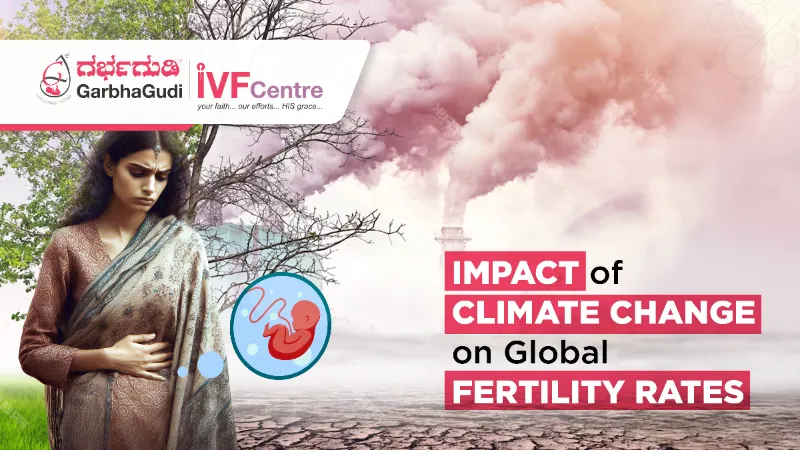How Climate Change Impacts Global Fertility Rates

Climate change, one of the most pressing issues of our time, is reshaping ecosystems, economies, and societies worldwide. Among its lesser-discussed consequences is its potential impact on global fertility rates. Fertility, a complex interplay of biological, environmental, and socio-economic factors, does not exist in isolation from the environment. Rising temperatures, environmental degradation, and socio-economic upheaval caused by climate change are influencing human reproductive behaviors, health, and choices in profound ways.
This article delves into the intricate relationship between climate change and global fertility rates, examining how environmental shifts affect biological fertility, societal trends, and reproductive decisions.
Understanding Fertility Rates
Fertility rate refers to the average number of children born to a woman over her lifetime. It is a critical demographic measure used to understand population growth and societal health. Fertility rates are influenced by a variety of factors, including:
Biological health: Hormonal, genetic, and physiological conditions affecting reproductive capacity.
Environmental conditions: Temperature, pollution, and resource availability.
Socio-economic factors: Access to healthcare, education, cultural norms, and economic stability.
The Direct Effects of Climate Change on Biological Fertility
1. Rising Temperatures and Reproductive Health
High temperatures, a direct result of global warming, can negatively impact human reproductive health in the following ways:
Reduced Male Fertility: Studies show that heat stress affects sperm quality, including motility, count, and morphology. Prolonged exposure to elevated temperatures can significantly reduce male fertility.
Impact on Female Fertility: High heat disrupts ovulatory cycles and hormonal balances in women, making conception more challenging.
Pregnancy Complications: Heatwaves increase the risk of pregnancy complications, such as preterm birth and low birth weight, which can deter individuals from pursuing parenthood in harsh climates.
2. Pollution and Reproductive Health
Climate change exacerbates pollution levels, including air and water contamination, which directly affect fertility:
Air Pollution: Fine particulate matter (PM2.5) and toxins can interfere with hormone regulation, reducing fertility in both men and women.
Water Pollution: Contaminants such as microplastics and endocrine-disrupting chemicals (EDCs) in water systems harm reproductive health.
3. Food Insecurity and Nutritional Deficiencies
Climate change-induced droughts and floods disrupt food supply chains, leading to malnutrition. Poor nutrition impairs reproductive health by:
Decreasing sperm and egg quality.
Interrupting menstrual cycles.
Increasing the prevalence of infertility-related disorders.
The Indirect Effects of Climate Change on Fertility Rates
1. Economic Instability
Climate change causes economic disruptions through loss of livelihoods, increased cost of living, and reduced access to resources. Economic insecurity often leads to lower fertility rates as individuals and couples delay or forgo having children due to financial concerns.
2. Migration and Displacement
Rising sea levels, natural disasters, and extreme weather events force millions of people to migrate. Displacement disrupts access to healthcare and family planning services, while the instability of refugee life discourages family formation.
3. Changing Societal Norms
As climate change alters living conditions, societal attitudes toward childbearing are shifting. For example:
In areas experiencing environmental crises, couples may choose to have fewer children due to uncertainty about the future.
Young adults in developed nations increasingly cite climate anxiety as a reason to delay or avoid parenthood.
The Role of Climate Anxiety
Climate anxiety, a psychological response to the fear of climate change, is becoming more prevalent, particularly among younger generations.
Impact on Parenthood Decisions: Many individuals feel reluctant to bring children into a world facing environmental uncertainty, resource scarcity, and potential ecological collapse.
Social Movements: Campaigns like "Birth Strike" highlight how climate change influences reproductive choices, with participants choosing not to have children as a form of activism or moral stance.
Regional Variations in Climate Change and Fertility
The effects of climate change on fertility rates are not uniform across the globe.
1. Low-income and Developing Nations
Countries in Sub-Saharan Africa, South Asia, and Southeast Asia are disproportionately affected by climate change.
In these regions, extreme weather events and resource scarcity may lead to higher fertility rates as families rely on larger households for labor and security.
However, rising mortality rates due to climate-related diseases could offset population growth.
2. High-Income Nations
Developed countries experiencing milder climate impacts tend to see declining fertility rates due to economic and lifestyle changes.
Climate anxiety and shifting cultural norms around parenthood further contribute to lower birth rates.
Population Dynamics and Feedback Loops
The interplay between climate change and fertility rates creates complex feedback loops:
Population Growth and Environmental Stress
High fertility rates in some regions exacerbate environmental degradation, increasing pressure on natural resources and amplifying climate change.Population Decline and Economic Stress
In contrast, low fertility rates in developed nations can lead to aging populations and economic stagnation, reducing societal resilience to climate change.
The Role of Policy and Adaptation
Addressing the intersection of climate change and fertility requires coordinated policy efforts that prioritize reproductive health and environmental sustainability.
1. Improving Reproductive Healthcare
Expanding access to fertility treatments and family planning services in areas affected by climate change.
Promoting education on the impact of climate change on reproductive health.
2. Enhancing Climate Resilience
Developing infrastructure to protect communities from extreme weather events.
Ensuring access to clean water, nutritious food, and healthcare in climate-affected regions.
3. Addressing Climate Anxiety
Supporting mental health initiatives to help individuals cope with climate-related stress.
Promoting climate action and advocacy to empower communities and reduce feelings of helplessness.
Future Outlook
The relationship between climate change and fertility rates underscores the interconnectedness of environmental, social, and economic systems. As climate change accelerates, its impact on fertility will likely become more pronounced, influencing global population trends and demographic structures.
By understanding these dynamics, policymakers, healthcare providers, and individuals can work together to create a future that prioritizes both environmental sustainability and reproductive health.
Climate change is reshaping the landscape of human fertility, influencing biological processes, societal norms, and reproductive choices. While its impact varies across regions and populations, the need for proactive measures to address these challenges is clear.
By fostering resilience and adaptability, societies can navigate the complex interplay between climate change and fertility, ensuring a healthier and more sustainable future for generations to come.